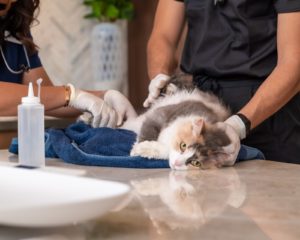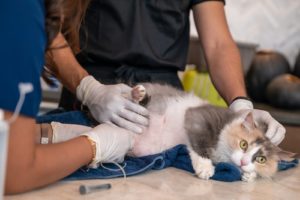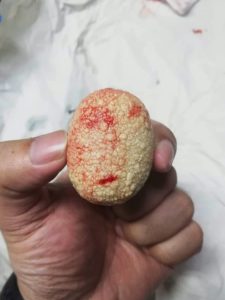Urinary Issues in Cats
by: Camille Virtucio, DVM

One of the most common issues that we see in cat house calls is urinary problems. Most calls we receive are from owners who notice their cats staying longer in the litter box, peeing in inappropriate places, and crying when peeing. Sometimes this is accompanied by increased drinking, inappetence, or sudden environmental changes.
So how do we approach these cases and what can be done to make the kitties feel better and get some answers?
Step 1: Physical exam
- look at the genital area, feel the bladder, check hydration status

Step 2: Diagnostics

– Use ultrasound to assess bladder structure and collect urine. An ideal sample is a sterile sample – collected via Cystocentesis.
We prefer a sterile collected sample since this is a good representation of the current microbiome status of the urine in the bladder. This is used for urine culture and antibiotic sensitivity testing
We do not culture free catch samples as these are already considered contaminated since it has passed through the external genital structures
It is also recommended to get blood samples to assess kidney function and rule out other endocrine diseases that lead to increased urination.

Step 3: Give antibiotics and anti-inflammatories
- option for injectables and oral medication
Step 4: Wait for diagnostic results and inform the owner of emergency clinical signs that will need immediate attention.
While waiting for diagnostic results, let us discuss the common reasons why cats go into pee problem mode:
1. Urinary tract infection
- This is the most common reason for urinary issues in cats and we always recommend antibiotics while waiting for diagnostic results. For some owners who are tight on budget and want to do a more conservative route, this is the assumptive diagnosis. We just diagnose based on response to antibiotic treatment.
- However, it is best to culture the urine to get answers on what type of bacteria is present and what antibiotic is best to use. I have seen urine cultures that are almost resistant to most common antibiotics. It happens and it happens quite often. This is pretty scary so I always recommend the culture of the urine sample.
2. Urinary Stones and Crystals

Courtesy of Dr. Marc Maligalig
- The presence of crystals or stones can irritate the urinary lining and leads to inflammation and a possible UTI. Crystal and stone formation can be caused by genetics, diet, dehydration, or other endocrine diseases that the pet has. This is diagnosed by urinalysis and looking at the urine sample under the microscope, and abdominal radiographs.
- Some crystals and stones can be dissolved using prescription diets, while some will need surgical intervention to fix. “Once a stone former, always a stone former” as we always say. These kitties will have to be on a special diet for life to prevent the recurrence of the stone formation.
3. Kidney Disease
- Kidney disease happens when the kidneys’ ability to screen and filter toxins is already compromised. This can be due to genetics, old age, recurrent UTI that didn’t receive the right antibiotic, or a complication of a heart problem. The best way to start with this is to look at basic bloodwork and assess kidney enzymes and electrolytes.
4. Hyperthyroidism or Diabetes mellitus
- These 2 conditions are possibilities if there is an increase in water consumption and are common in older kitties. Both of these diagnoses are treatable and manageable if diagnosed early. Increased water consumption can lead to increase urine production; hence, these are included in this list. However, there are also other clinical signs that can be observed for these conditions and it is very important to be as thorough when telling your veterinarian any history. This helps us streamline our approach to diagnosing and treatment.
5. Feline Idiopathic Cystitis (FIC)
- FIC is a diagnosis of exclusion. No veterinarian will diagnose your kitty with FIC without ruling out all the abovementioned possibilities. FIC is simply an unexplainable sterile inflammation of the bladder in cats. There is no proven cause for this but most references relate it to stress. I commonly see this condition in cats when there is a sudden change in the environment. Cats are very good at hiding their discomfort but they can never hide them from their bladders. The bladder protective barrier goes down due to stress signals from the brain and thus leads to inflammation. Urinalysis will contain so much pus and blood, but there will be no bacteria or growth in the culture – this is the hallmark of FIC. With these cats, we offer medications to relax them and we watch out for the occurrence of UTIs, crystals, and stones as these can still happen due to persistent inflammation.
6. Behavioral Issues
- This is a tricky diagnosis. I usually refer such cases to a veterinary behaviorist to help the owner and pet get a more thorough assessment. This will determine stressors and what can be done in the household to minimize situations that trigger the kitty to pee in different places. This, of course, is under the assumption that all the common diagnoses have been ruled out.
If you have concerns regarding urinary issues with your pet, let us help you.

